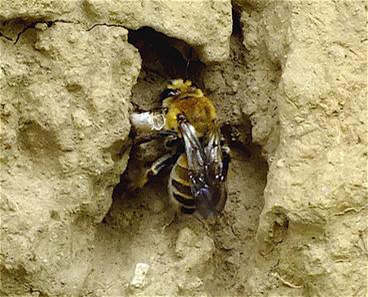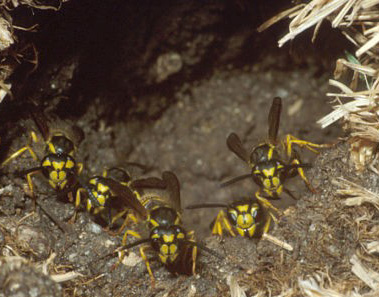
More than half of North America's wild bees are in decline, and 1 in 4 at risk of extinction. Native bees, honey bees, wasps and other pollinators are keystone species and provide pollination services for over 30 percent of human food. The best crop pollinators are a combination of honey bees and wild bees.
Ground nesting or miner bees are solitary bees that create underground galleries, with queens living individually and raising their own young. The entrances to the nests are small piles or patches of bare soil. They do not form hives, but several females may nest in the same area. Ground bee queens do not defend their nesting areas and are very docile and unlikely to sting, posing little or no threat to people. The males often patrol an area inhabited by females seeking mates. While the males can be very active and seem aggressive, they lack a sting and are also harmless. Like other bees, they are active foragers of nectar and pollen from flowers, making them beneficial pollinators.
Their nest entrances are small mounds of soil a few inches across. While they may briefly detract from the aesthetics of a well-tended lawn, they do absolutely no harm to the grass or soil - even improving it as their nests function as aeration holes, improving the penetration of water and nutrients. Eventually, as the nests are abandoned after the spring nesting season, the soil washes back into place with rain, disappearing completely.


Fruits and seeds derived from insect pollination are also a major part of the diet of birds and mammals ranging from red-backed voles to grizzly bears. There are an estimated 460 wild bees in Minnesota. The rusty patched bumble bee (Bombus affinis) was once abundant but is now a federally endangered species. In addition, Minnesota has 8 state-listed endangered pollinator species, 1 threatened, 10 species of special concern and 19 non-listed in greatest conservation need.
Bumble bees and other pollinators need high quality habitat to survive. For the endangered rusty patched bumble bee, urban habitats can be just as important as parks or rural landscapes. Keeping areas pesticide free is important for habitat quality and for the recovery of the rusty patched bumble bee.
Principles of Bee Conservation
- Habitat Conservation is a priority for safeguarding bees. Unfortunately, only 1% of original prairie habitat is left in Minnesota. Many species depend on this type of habitat and the species of plants that inhabit it. If we can increase native prairie habitat in urban and rural areas, the bees will come along with it.
- Season-long shelter: Leave some sandy open areas for ground nesting bees. Brush, leaf and mulch piles, logs, and overgrown areas provide safe places to overwinter or hibernate. Wait until late spring (May) to clean backyard gardens for hibernating bees. Many species of bees overwinter in hollowed out stiff plant stems.
- Food: Plant diverse flowers that bloom from early spring through fall. Pollinators collect nectar and pollen from a variety of flowering plants including native plants, heirloom garden plants, trees, weeds and crops. In your yard, plant heirloom and native species such as salvia and milkweed, shrubs like ninebark and pussy willow, and flowering trees like basswood and plum.
- Avoiding the use of pesticides is one of the most important conservation decisions we can make. Pesticide drift and contamination from industrial agriculture is a major contributer to butterfly die offs.
Steps to Conserve Bees
- Provide nectar plants that bees prefer. Plants such as yellow sunflower, black-eyed susans and goldenrods, pink joe-pye weed and fireweed, red bee balm/bergamot, and Mexican sunflower, purple coneflower, verbena, wild asters, ironweed and tall buddleia provide plentiful color.
- Include multiple habitats for different needs. Leave some sandy open areas for ground nesting bees. Brush, leaf and mulch piles, logs, and overgrown areas provide safe places to overwinter or hibernate. Wait until late spring (May) to clean backyard gardens for hibernating bees. Many species of bees overwinter in hollowed out stiff plant stems. Use biodiversity as a guide to include a variety of water, protection, sun, flowers, grasses, shrubs and trees.
- Reduce or stop using pesticides. Instead, accept some plant damage, build biodiversity and soil health for natural pest control. If pesticides are necessary, use more benign spot treatments and alternative control methods such as oils, soaps, and microbial insecticides such as Bacillus thuringiensis (Bt).
- Use integrated pest management (IPM) to control insects and diseases:
- When choosing plants, pick naturally resistant plants.
- Inspect and monitor your plants' health on a regular basis, before problems are out of control.
- Instead of routinely spraying for insects, spot treat problems with soft pesticides such as insecticidal soaps, oils, and biorational products such as spinosad.
- Adopt biorational practices that use naturally occurring biological control agents, such as parasitoids and predatory insects.
-
Plant both annual and perennial plants for butterflies. Some plants, shrubs or trees produce nectar AND pollen, others only produce one or the other. Some plants and trees are also host plants for larvae and others are not. Remember to source plants and trees that have NOT been treated with pesticides. Pesticides harm butterflies, moths, pollinators and other non-target beneficial insects.